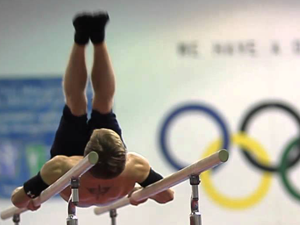

An integral part of the gymnastics coaching process is to provide athletes with drills to aid in their skill development. Drills can help gymnasts learn skills faster, and with the correct techniques. Gym Drill Pro aims to provide qualified coaches with a variety of teaching methods which they can introduce in their own training programs. On Gym Drill Pro you can find hundreds of detailed descriptions and accompanying images for every skill progression. This website is explicitly intended to support qualified coaches in their daily coaching processes. DO NOT practice any of these drills without the guidance of proper professionals.

The gymnast should perform a high amplitude backswing. At the bottom the gymnast should kick strong with their heels, pressing down from their shoulders. Their head should stay in a neutral position. When their legs are over horizontal, the gymnast should move their arms sideways with downward pressure on the rings, performing a back circle. After completing the circle, the gymnast should keep their arms by their sides and hold front support on the top of the rings.

The gymnast should begin in upper arm support with their arms bent around 90 degrees. The front swing technique begins at the highest point in the back swing in a hollow body position. The body should arch slightly, and snap down through the bottom of the swing. On the way up to the highest point in the front swing, the gymnast should maintain a hollow body. From the top of the front swing, the back swing technique begins. The gymnast’s body should be extended until the very bottom of the swing. Next, the gymnast should kick with their heels and create a slightly arched body position.

Straddle legs sideways wide throughout the swing. Upper body stays upright throughout the swing. Hips are in, do not support hollow body position. Straight body is moving in front plane without any deviations. When gymnast lifts left leg, left arm pushes left pommel and center of gravity moves into right pommel/arm. Vice versa with right leg lift...

At the highest point in the back swing, the shoulders should be extended with the rings going slightly sideways. The body should be in an arched position. From the top of the swing, continuous shoulder extension toward the bottom of the swing must be maintained. This helps the gymnast maintain the arched body position until the bottom of the swing. At the bottom, the gymnast should kick the legs forward and upward to make their entire body turn over as fast as possible. The gymnast should attempt to kick from their upper chest at the bottom. Shoulder should remain extended and stay down until the entire body turns over completely. The rings should be pushed backward when the gymnast’s feet are pointed towards the ceiling. The rings should turn parallel (wrists facing one another). The rings should not go sideways during this portion of the swing. The final position is a higher point of the front swing, where the body should be in a slight hollow position with arms tight and parallel...

The gymnast should run towards the table and gradually increase their speed. Their last step before reaching the springboard should be long and low. They should jump on the springboard with tight knees and their legs together. Their hands should reach the table as fast as possible. Their first arm should be bent, with this hand rotated one quarter to the side. The second hand should be placed further away, depending on the gymnast’s speed. This wide armed method is essential for creating a better block and higher take-off. The body should reach a half turn position in the handstand, with an energetic block and whip. After the round-off, a back salto should follow before the gymnast’s landing. The knees should be bent in order to absorb the force from landing.